
Why Wear Compression Socks
Why Wear Compression Socks
1.What are compression socks
Compression stockings are specialized hosiery designed to apply graduated pressure to the legs.
- Function: Improve blood circulation: By applying pressure from the ankle up, they help push blood back towards the heart. This is especially beneficial for people who stand or sit for long periods, as it reduces the risk of blood pooling in the lower extremities.
- Reduce swelling: The graduated pressure helps limit the accumulation of fluid in the tissues, effectively reducing swelling in the legs.
- Prevent varicose veins: They can act as a preventive measure for those at risk of developing varicose veins by providing support to the veins and preventing them from becoming enlarged and twisted.
- Alleviate discomfort: People experiencing leg discomfort, pain, or heaviness often find relief with compression stockings. The pressure can ease muscle fatigue and soreness.
- Reduce the risk of deep vein thrombosis (DVT): In certain situations such as after surgery, during long flights, or for those with immobility issues, compression stockings can lower the risk of DVT by promoting blood flow and preventing blood clots.
- Types: There are different levels of compression available. Mild compression stockings are suitable for those with minor leg fatigue or for preventive purposes. Medium and strong compression stockings are typically prescribed for people with more severe venous disorders.
- Materials: They are made from a variety of materials such as nylon, spandex, and cotton blends. Some are designed to be breathable and moisture-wicking to keep the legs comfortable throughout the day.

2.Function of compression socks
Introduction to the main functions of compression stockings:
- Improving blood circulation: Compression stockings apply graduated pressure from the ankle up, which helps push blood back towards the heart. This is especially beneficial for people who stand or sit for long periods, as it reduces the risk of blood pooling in the lower extremities and improves overall blood circulation.
- Reducing swelling: The pressure exerted by compression stockings can limit the accumulation of fluid in the legs, thereby reducing swelling. This is particularly useful for those with conditions such as chronic venous insufficiency, pregnancy, or after long periods of travel.
- Preventing varicose veins: By providing support to the veins, compression stockings can help prevent the development of varicose veins. They can also slow the progression of existing varicose veins and relieve symptoms such as pain, heaviness, and itching.
- Enhancing athletic performance: Some athletes use compression stockings to improve blood flow to the muscles, reduce muscle fatigue, and enhance recovery after exercise.
- Post-surgery recovery: Compression stockings are often recommended after certain surgeries to reduce swelling, prevent blood clots, and promote healing.

3.Putting on Compression Socks
4 easy steps:
- 1.Turn the upper half of the sock inside out.Reach into the compression sock with one hand and grab the toe of the sock. Then use your hands to turn the upper half of the compression sock inside out.
- 2.Place your foot in the sock.Once you have the compression sock turned inside out, gently place your foot in the toe of the sock. Then slide the stocking up over your heel. Make sure the top of the stocking remains inside out.
- 3Slide the sock up your leg.Once your heel is securely inside the sock, gently slide the sock up your leg. Do this as slowly and gently as possible to prevent tearing holes in the stocking or stretching it out.
- 4.Do not pull on the top of the sock.Pulling on the top of a compression sock may cause the sock to rip. Never attempt to put on compression socks by pulling them on by the top of the sock. This can also cause unwanted stretching of the fabric.








